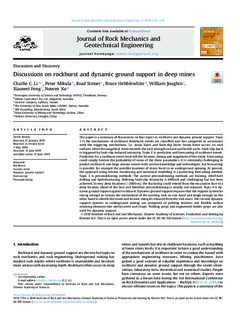| dc.contributor.author | Li, Charlie Chunlin | |
| dc.contributor.author | Mikula, P | |
| dc.contributor.author | Simser, B | |
| dc.contributor.author | Hebblewhite, B | |
| dc.contributor.author | Joughin, W | |
| dc.contributor.author | Feng, X.W. | |
| dc.contributor.author | Xu, N.W. | |
| dc.date.accessioned | 2020-02-26T09:43:21Z | |
| dc.date.available | 2020-02-26T09:43:21Z | |
| dc.date.created | 2019-12-10T22:38:34Z | |
| dc.date.issued | 2019 | |
| dc.identifier.citation | Journal of Rock Mechanics and Geotechnical Engineering. 2019, 11 (5), 1110-1118. | |
| dc.identifier.issn | 1674-7755 | |
| dc.identifier.uri | http://hdl.handle.net/11250/2643822 | |
| dc.description.abstract | The paper is a summary of discussions on four topics in rockburst and dynamic ground support. Topic1 is the mechanisms of rockburst. Rockburst events are classified into two categories in accordancewith the triggering mechanisms, i.e. strain burst and fault-slip burst. Strain burst occurs on rocksurfaces when the tangential stress exceeds the rock strength in hard and brittle rocks. Fault-slip burstis triggered by fault-slip induced seismicity. Topic 2 is prediction and forecasting of rockburst events.Prediction for a rockburst event must tell the location, timing and magnitude of the event. Forecastingcould simply foresee the probability of some of the three parameters. It is extremely challenging topredict rockbursts and large seismic events with current knowledge and technologies, but forecastingis possible, for example the possible locations of strain burst in an underground opening. At present,the approach using seismic monitoring and numerical modelling is a promising forecasting method.Topic 3 is preconditioning methods. The current preconditioning methods are blasting, relief-holedrilling and hydrofracturing. Defusing fault-slip seismicity is difficult and challenging but has beenachieved. In very deep locations (>3000 m), the fracturing could extend from the excavation face to adeep location ahead of the face and therefore preconditioning is usually not required. Topic 4 is dy-namic ground support against rockburst. Dynamic ground support requires that the support system bestrong enough to sustain the momentum of the ejecting rock on one hand and tough enough on theother hand to absorb the strain and seismic energies released from the rock mass. The current dynamicsupport systems in underground mining are composed of yielding tendons andflexible surfaceretaining elements like mesh/screen and straps. Yielding props and engineered timber props are alsoused for dynamic support. | |
| dc.language.iso | eng | |
| dc.publisher | Elsevier | |
| dc.rights | Attribution-NonCommercial-NoDerivatives 4.0 Internasjonal | |
| dc.rights.uri | http://creativecommons.org/licenses/by-nc-nd/4.0/deed.no | |
| dc.title | Discussions on rockburst and dynamic ground support in deep mines | |
| dc.type | Peer reviewed | |
| dc.type | Journal article | |
| dc.description.version | publishedVersion | |
| dc.source.pagenumber | 1110-1118 | |
| dc.source.volume | 11 | |
| dc.source.journal | Journal of Rock Mechanics and Geotechnical Engineering | |
| dc.source.issue | 5 | |
| dc.identifier.doi | 10.1016/j.jrmge.2019.06.001 | |
| dc.identifier.cristin | 1759082 | |
| dc.description.localcode | c2019 Institute of Rock and Soil Mechanics, Chinese Academy of Sciences. Production and hosting by Elsevier B.V. This is an open access article under the CCBY-NC-ND license (http://creativecommons.org/licenses/by-nc-nd/4.0/). | |
| cristin.unitcode | 194,64,90,0 | |
| cristin.unitname | Institutt for geovitenskap og petroleum | |
| cristin.ispublished | true | |
| cristin.fulltext | original | |
| cristin.fulltext | | |
| cristin.qualitycode | 1 | |

